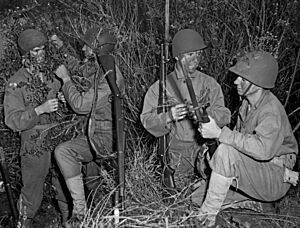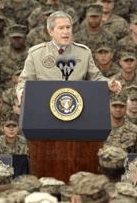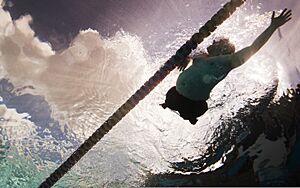Marine Corps Base Camp Pendleton facts for kids
Quick facts for kids Marine Corps Base Camp Pendleton |
|
|---|---|
| Near Oceanside, California in the United States | |
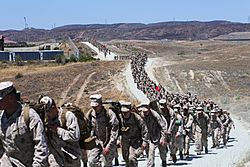
Marines hiking at Camp Pendleton during 2014
|
|
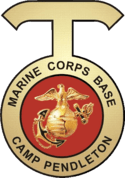 |
|
|
Location in the United States
|
|
| Coordinates | 33°12′53.1″N 117°23′15″W / 33.214750°N 117.38750°W |
| Type | Marine Corps base |
| Area | > 125,000 acres (51,000 hectares) |
| Site information | |
| Owner | Department of Defense |
| Operator | US Marine Corps |
| Controlled by | Marine Corps Installations West |
| Condition | Operational |
| Site history | |
| Built | March – September 1942 |
| In use | 1942 – present |
| Garrison information | |
| Current commander |
Brigadier General Jason G. Woodworth |
| Garrison | I Marine Expeditionary Force |
| Airfield information | |
| Airfield | Marine Corps Air Station Camp Pendleton |
Marine Corps Base Camp Pendleton is a huge base for the United States Marine Corps on the West Coast. It's one of the biggest Marine Corps bases in the United States. You can find it along the coast of Southern California in San Diego County.
The base was created in 1942. Its main purpose was to train U.S. Marines for World War II. By 1946, it became the home of the 1st Marine Division. The base was named after Major General Joseph Henry Pendleton. He had always wanted a training base for the Marine Corps on the West Coast. Today, many important Marine units train here. This includes the I Marine Expeditionary Force.
Contents
A Look Back in Time
Before World War II: Rancho Santa Margarita
In 1769, a Spanish group led by Captain Gaspar de Portolá explored this area. They named the land Santa Margarita. Later, Spanish missions were built, like Mission San Luis Rey. This mission controlled the Santa Margarita area.
After 1821, Mexico became independent from Spain. Some soldiers who stayed in California received large land grants. These lands were called ranchos. In 1841, two brothers, Pio Pico and Andrés Pico, became the first private owners of Rancho Santa Margarita. More land was added, and it became Rancho Santa Margarita y Las Flores. This name stayed until the Marine Corps bought it in 1942. The base's logo still shows the ranch's old cattle brand.
In 1863, an Englishman named John (Don Juan) Forster bought the ranch. He made the ranch house bigger and turned it into a successful cattle business. His family had to sell the ranch in 1882 because of dry weather. A rich cattleman named James Clair Flood bought it. An Irishman named Richard O'Neill managed the ranch. He eventually owned half of it. Under his son, Jerome, the ranch made a lot of money. The ranch house was also updated.
Camp Pendleton in World War II
In the early 1940s, the Army and Marine Corps needed a large training base. In February 1942, it was announced that the 122,798 acres (497 km2) of Rancho Santa Margarita y Las Flores would become the biggest Marine Corps base. It was named after Major General Joseph Henry Pendleton.
Building began in April 1942. It was a temporary base made of wood. After five months, the 9th Marine Regiment became the first troops to use the new base. On September 25, 1942, President Franklin D. Roosevelt officially opened the base. During the war, Marines learned about landing craft and how to fight on beaches. After World War II ended in 1945, the base helped soldiers return home.
After the Wars
During the Korean War, Camp Pendleton grew bigger. New buildings were added, including Camp Horno. About 200,000 Marines trained here for the Korean and Vietnam Wars.
Since 1954, Camp Pendleton has offered a program called "Devil Pups." This training is for teenagers aged 14 to 17. It helps them get fit, learn discipline, and feel proud of their country and the Marine Corps.
A special horse named Sergeant Reckless served with the Marines in Korea. There is a plaque and statue at the camp's stables to remember her.
In 1975, Camp Pendleton helped Vietnamese people who had to leave their homes. This was called Operation New Arrivals. Over 50,000 refugees came to the base. It was the largest humanitarian airlift in history.
Camp Pendleton has continued to grow. Its first tent camps have been replaced by over 2,600 buildings. There are also more than 500 miles of roads. The original ranch house and the Las Flores Adobe are now National Historic Sites. This helps preserve the base's history.
Camp Pendleton Today
The base covers over 125,000 acres (506 km2) of land. Its varied landscape allows Marines and other military branches to train all year. Training that involves landing from the sea happens along the base's 17 miles (27 km) of coastline. The main part of the base is called the Mainside Complex. The northern part is used for impact training. About 100,000 people are on the base during the day.
New Marines from Marine Corps Recruit Depot, San Diego spend four weeks at Pendleton's Edson Range. Here they get field training. After finishing recruit training, new infantry Marines return to the base's School of Infantry for more training.
Camp Pendleton is the last large undeveloped part of the California coastline south of Santa Barbara. In 2015, there was a plan to build a large civilian airport here, but it didn't happen.
Since 2004, Camp Pendleton has used a special radar system called STARS. This system helps them train for air traffic control.
Camp Pendleton's color guard has been part of many sporting events. They have also performed at the 1996 Republican National Convention. They often accompany singers performing the national anthem.
There have been discussions about building a toll road through parts of the base. The Marine Corps has said that this would make it harder for them to train. It would also harm natural areas and endangered animals.
Areas of Camp Pendleton

Camp Pendleton is divided into many areas, each with different purposes.
- Mainside: Areas 11-16 are known as "Mainside." This is where many important units are located. It includes housing, the 1st Marine Division headquarters, and the Naval Hospital Camp Pendleton.
- Camp Del Mar (Area 21): This area is home to the I Marine Expeditionary Force Headquarters. It also has units that work with amphibious vehicles.
- MCAS Camp Pendleton (Area 23): This is the base's airfield, where Marine Aircraft Group 39 is located.
- Edson Range (Area 31A): This is where Marines get their weapons and field training.
- School of Infantry (Area 52): New Marines come here for more training after recruit training.
- Other Camps: There are many other camps like Camp Horno, Camp Las Pulgas, and Camp San Mateo. These camps house various Marine regiments and support battalions.
Nature and Wildlife at Camp Pendleton
Camp Pendleton was built on a large area of coastal land. This land used to have a river mouth and many salt marshes. The base also has oak woodlands, coastal dunes, bluffs, and different types of wetlands. Wildfires can happen here.
Scientists study the undeveloped areas of the base. These areas have rare and endangered California habitats. The Department of Defense has plans to protect these natural places.
The base is a breeding ground for birds like the western snowy plover and California gnatcatcher. The coastal bluffs have rare plants like the Pendleton button-celery. Rare mammals here include the Pacific pocket mouse and Stephens's kangaroo rat.
The Bison Herd
Between 1973 and 1979, fourteen American bison were brought to Camp Pendleton from the San Diego Zoo. These bison now roam in different training areas on the base. In early 2021, there were about 90 adult bison. About 14 calves were expected that April.
See also
 In Spanish: Base del Cuerpo de Marines Camp Pendleton para niños
In Spanish: Base del Cuerpo de Marines Camp Pendleton para niños



